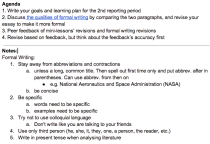This week, members of my personal learning network (PLN) have inspired me with a couple of good English teaching ideas, which I’d like to share. I have not tried these out yet, and I still need to develop them further, but I really like their potential. By writing this blog post, I have been able to reflect on these ideas a bit more. As always, all feedback and suggestions are welcome.
Thanks to those of you in my PLN who share your knowledge with others and who pass along good ideas as you come across them.
Lesson 1: Writing Conclusions
The first lesson idea came to me from Meredith Boullion via Twitter and is about teaching students to write conclusions. Meredith received the idea from Caroline Trull’s blog post.
The lesson is very simple. In fact, it’s so simple that I wouldn’t be surprised to find out that I’m the only English teacher not doing something like this already.
1. Teach the students the goals of a conclusion.
2. Provide the students with examples of different styles of conclusions.
3. The students read essays with the conclusions removed.
4. The students write their own conclusions for those essays.
5. The students see the original conclusions.
6. The students reflect on and discuss how their own conclusions are different than the authors’, and which ones are better and why.
That’s it. It’s a very simple use of the constructivist predict-observe-explain (POE) model of teaching (White & Gunstone, 1992) where the students encounter knowledge that is different than what they held previously and then learn by coming to terms with it.
I’m not sure if I’d provide the students with the examples of different styles of conclusions at the beginning, though, or if I’d let them discover those different styles in steps 5 and 6 before giving them some sort of reference for the different types of conclusions. That’s something I’ll have to think about some more. As well, I would use this lesson with my grade 11 students right before they had to write their own conclusions for their research papers. That way they’d be putting their learning to use immediately.
Lessons Two and Three: Narration within Narration
I like reading literature that has interesting narrators.
-
“Cathedral” by Raymond Carver – The narrator is the main character, but the narrator’s opinion of the story’s events is different than the main character’s is at the end of the story; therefore, the narrator’s realization must have come between the end of the story’s events and his telling of those events.
-
True Grit by Charles Portis – There are many reasons I couldn’t put this book down, but one of them was the strength of the narrator’s voice.
-
The Princess Bride by William Goldman – Aside from being a fun read, this novel has some interesting interruptions by the narrators.
-
Middlemarch by George Eliot – At work two years ago, two colleagues were talking about the intrusive narrator in Middlemarch, so I knew I’d have to read it. Then I read Daniel Deronda, which has a similar type of narrator.
-
Green Grass, Running Water by Thomas King – The narrator is often interrupted by the characters of his own story talking directly to him. Often, they inform him him that he is telling the story incorrectly, so he has to retell portions of it.
-
The Reivers by William Faulkner – I have not read this, but it was recommended in the comments of Laura Gibb’s Google+ post that I mention below. Apparently, the story is framed by only two words at the beginning of the novel: “Grandfather said”. That novel is now on my “To Read” list.
Because of my interest in narrators, I latched onto a Google+ post by Laura Gibbs (She also has a blog post about the same topic). In part of it, she discusses her interest in framed narratives (narrator within a narrator), and how she’d like to use that as a focus for her students’ reading and writing.
She was thinking of having her students write a narrative and then frame it in another narrative. I think this is a worthwhile exercise, but I will need to sort out best method of teaching students to do this and to have them work on it. It looks like it would be a good exercise not only in structure but also in voice and transition. It would probably be best for me to assign this after the class has read Frankenstein and discussed that novel’s narrative structure.
Of course Frankenstein, by Mary Shelley, is another good story for the study of narration with its narrator within a narrator within a narrator. Since it pairs well with Coleridge’s “Rime of the Ancient Mariner” anyway, and since the poem has a narrator within a narrator, it may be a good time to compare aspects and effects of the narrators, or perhaps the story-telling honesty of Victor Frankenstein and the mariner.
So there you go. In one week, I have three lesson ideas that are inspired by members of my PLN. Thanks again to Caroline Trull, Meredith Boullion, Laura Gibbs, and the commenters in those posts for sharing your knowledge and ideas with the rest of us.
References
Bouillion, M. https://twitter.com/realtechfored/status/420376306380193792
Gibbs, L. (2014, Jan. 7). Third person storyteller style [Google+ post]. Retrieved from https://plus.google.com/u/0/111474406259561102151/posts/Kq465FU6bRu
Gibbs, L. (2014, Jan. 7). Third person storyteller style [Web log]. Retrieved from http://writingwithaesop.blogspot.ca/2012/01/paired-storytellers-stories-in-dialogue.html
Trull, C. (2013, Dec. 16). Writing superhero conclusions with the phantom endings exercise
[Web log]. Retrieved from http://www.edutopia.org/blog/writing-conclusions-phantom-endings-exercise-caroline-trull
White, R. & Gunstone, R. F. (1992). Probing Understanding. London: The Falmer Press, chapter 2 & 3.

